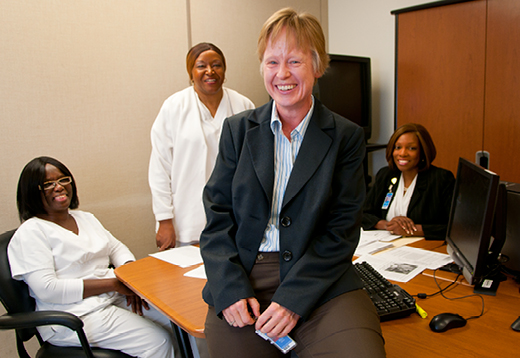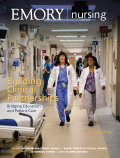Wounds of a Different Sort

"We try to avoid the academic 'silo' effect," says Ursula Kelly (center).
|
|
THE ATLANTA VETERANS AFFAIRS MEDICAL CENTER:
Caring for veterans, mind and body
War—and the fear, violence, and death that come with it—often leaves wounds deep in the psyche that persist for a lifetime. Post-traumatic stress disorder (PTSD) among veterans is a well-documented and difficult to treat phenomenon.
Female veterans, including those returning from Iraq and Afghanistan, often bring home psychic wounds of a different sort.
“The number of female veterans who have experienced military sexual trauma is staggering,” says Ursula Kelly, a nurse scientist at the Atlanta Veterans Affairs Medical Center (VAMC) and an assistant professor at the School of Nursing. “There is a tremendous need for awareness, research, and treatment of this increasingly recognized problem. The military is doing a lot to address the sexual assault and serious, ongoing sexual harassment that occurs, and now, here at the VAMC, we’re dealing with the problem after the fact.”
Kelly, a psychiatric/mental health nurse practitioner with a nursing doctorate, came to Emory in 2009 from the University of North Carolina at Chapel Hill, where she studied issues of intimate partner violence among Latinas. “The broader scope of my research is PTSD related to interpersonal violence,” she says.
Before Kelly joined Emory, the VAMC had achieved Magnet status for high-quality nursing. During the Magnet evaluation process, the American Nurses Credentialing Center identified nursing research and evidence-based practice as areas for improvement. Kelly’s VAMC position was created in response. In addition toconducting her own research, she encourages nurses to seek research evidence to answer questions about clinical issues. She also teaches them to use their own ideas and clinical observations to formulate research questions.
One nurse, for example, is conducting a study about skin ulcer prevention. “She is testing the use of ultrasound at the bedside to assess tissue damage in patients who are bed-bound,” Kelly explains. “Measuring the difference between what the ultrasound machine shows as compared with clinical observation should help determine how often patients need to be repositioned to prevent skin ulcers.”
Nurses in the cardiac catheterization lab are working with an interdisciplinary, international research team to study patients’ awareness and brain changes during cardiac arrest. Another nurse recently implemented an evidence-based practice educational program for families caring for elders at home.
Emory nursing Dean Linda McCauley and Sandy Leake, associate director for nursing and patient care services at the Atlanta VAMC, pushed for creation of the nurse scientist position. They structured a position that is a new model for the nursing school and the VAMC—a nursing faculty member with a joint appointment at a medical center. “The position I hold is a bridge, so we can avoid the academic ‘silo’ effect,” says Kelly. “Schools and hospitals need to work together more closely.”
Learning about the stark realities of caring for military veterans at the VAMC can be compelling for Emory nursing students, she notes. In her faculty role, she mentors BSN students in a professional development seminar that emphasizes social responsibility and service learning.
“There is a commitment here to social responsibility and a continuum of service learning throughout nursing education that sealed my decision to come to Emory,” says Kelly. “Helping build a bridge between the VAMC and the nursing school is a key part of that.”—Valerie Gregg



